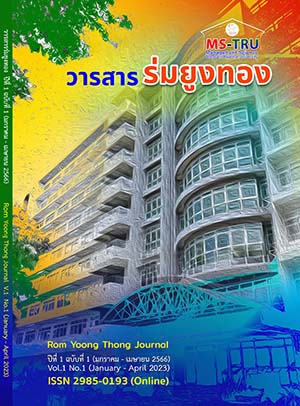Study of herbal Pharmacopoeia for dysmenorrhea treatment Thai traditional medicine
Keywords:
Herbal pharmacopoeia, Dysmenorrhea, Thai Traditional Medicine, Thai wisdomAbstract
This research was to study traditional herbal remedies for treating menstrual pain and analyze the taste of each remedy. The study gathered information from ancient Thai medical texts (Medical wisdom and literary heritage of the nation) by synthesizing ancient Thai words related to the menstrual pain. The remedies were then analyzed, classified, and grouped based on their effectiveness for different types of menstrual pain and irregularities. The results showed that the most commonly used herbs for treating menstrual pain were sa-khan and cha-phlu, with a total of 13 remedies. The second most commonly used herbs were jatamansi, dried ginger, black pepper, and dill, with a total of 12 remedies. In terms of taste, bitter was the most commonly used taste for treating menstrual pain, followed by ginger, which was the most commonly used herb for treating irregular menstrual cycles, with a total of 42 remedies. Dill was the second most commonly used herb for treating irregular menstrual cycles, with a total of 36 remedies. The spicy taste was found to be the most commonly used taste for treating delayed menstruation, and it was used to help promote blood circulation and alleviate bloating. It can be seen that in Thai traditional medicine, bitter-tasting remedies are used to treat menstrual pain because they are believed to nourish the blood and correct blood deficiency, while spicy-tasting remedies are used to promote menstrual flow and alleviate abdominal discomfort.
References
กรมวิชาการ กระทรวงศึกษาธิการ. (2542). พระคัมภีร์มหาโชตรัตน์ (พิมพ์ครั้งที่ 2). กรุงเทพฯ: คุรุสภาลาดพร้าว.
คณะกรรมการแห่งชาติด้านยา. (2551). บัญชียาจากสมุนไพร 2549. กรุงเทพมหานคร: โรงพิมพ์ชุมนุมสหกรณ์การเกษตรแห่งประเทศไทย.
ธัญลักษณ์ ปู่คำสุข. (2555). การวิเคราะห์ผลการรักษาอาการปวดประจำเดือนและประจำเดือนมาไม่ปกติโดยกระบวนการรักษาด้วยตำรับยาประสะไพล. วิทยานิพนธ์ปริญญาการแพทย์แผนไทยมหาบัณฑิต มหาวิทยาลัยราชภัฏเชียงราย.
นเรศร สุขเจริญ และคณะ. (2547). ตำรานารีเวชวิทยา (พิมพ์ครั้งที่ 4). กรุงเทพฯ: โรงพิมพ์จุฬาลงกรณ์มหาวิทยาลัย.
เบญจมาภรณ์ บุตรศรีภูมิ และยุวดี วิทยพันธ์. (2562). ความชุก ผลกระทบและวิธีการจัดการต่ออาการปวดประจําเดือนในนักศึกษาพยาบาล. วารสารพยาบาลสงขลานครินทร์, 39(1), 41-52.
มูลนิธิฟื้นฟูส่งเสริมการแพทย์ไทยเดิมฯ และ โรงเรียน อายุรเวทธำรง สถานการณ์แพทย์แผนไทยประยุกต์คณะ แพทยศาสตร์ ศิริราชพยาบาล มหาวิทยาลัยมหิดล. (2555). ตำราการแพทย์ไทยเดิม (แพทยศาสตร์สงเคราะห์ฉบับอนุรักษ์) เล่มที่ 1 (พิมพ์ครั้งที่ 3). กรุงเทพฯ: ศุภวนิชการ การพิมพ์.
ราตรี พระนคร. (2559). การติดตามผลของการใช้ยาสมุนไพรตำรับ “สาวสองพันปี” ต่ออาการแสดงในระหว่างมีประจำเดือน. วารสาร มฉก.วิชาการ มหาวิทยาลัยหัวเฉียวเฉลิมพระเกียรติ, 19(38), 13-19.
สมศักดิ์ นวลแก้ว. (2543). พฤกษเคมีและการศึกษาฤทธิ์ทางเภสัชวิทยาของตํารับยาแผนไทย (ประสะไพล). วิทยานิพนธ์ปรัชญาดุษฎีบัณฑิต มหาวิทยาลัยมหิดล.
สร้อย อนุสรณ์ธีรกุล และคณะ. (2542). ลักษณะการมีประจำเดือนในสตรีวัยรุ่น ปัญหาและการดูแลตนเองวารสารวิจัยมหาวิทยาลัยขอนแก่น, 4(2), 67-77.
สุรเกียรติ อาชานานุภาพ. (2551). ตำราการตรวจโรคทั่วไป เล่ม 2 (พิมพ์ครั้งที่ 5). กรุงเทพมหานคร: โฮลิสติก พับลิชชิ่ง.
Lefebvre G, Pinsonneault O, Antao V, Black A, Burnett M, Feldman K, Lea R, Robert M, SOGC. (2013). Primary dysmenorrhea consensus guideline. J Obstet Gynaecol Can, 27(12), 1117-46.
ZakariaZA, PatahuddinH, Mohamad AS, Israf DA, Sulaiman MR. (2010). In vivo anti-nociceptive and anti-inflammatory activities of the aqueous extract of the leaves of Piper sarmentosum. Journal of ethnopharmacology. 128, 42-48.
Downloads
Published
How to Cite
Issue
Section
License
Copyright (c) 2023 คณะวิทยาการจัดการ มหาวิทยาลัยราชภัฏเทพสตรี

This work is licensed under a Creative Commons Attribution-NonCommercial-NoDerivatives 4.0 International License.





